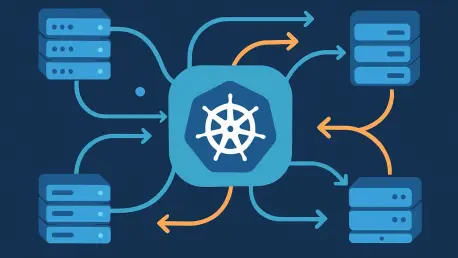Kubernetes stands as the cornerstone of container orchestration, managing a vast array of environments, from compact developer setups to sprawling AI and data processing infrastructures. Its ability to handle diverse workloads with precision has made it indispensable for organizations aiming to scale efficiently. With each release, Kubernetes introduces enhancements that refine its capabilities, addressing both operational simplicity and performance demands.
The arrival of version 1.34 marks a significant step forward, particularly in the realm of traffic distribution. This update brings two pivotal policies, PreferSameNode and PreferSameZone, designed to revolutionize how traffic is routed within clusters. These features prioritize locality, directing requests to endpoints that are physically or logically closer to the client, thereby enhancing efficiency across the board.
By focusing on local routing preferences, Kubernetes v1.34 tackles critical issues like latency reduction and cost optimization. These policies ensure that traffic avoids unnecessary network hops and minimizes expensive cross-zone transfers in cloud environments, while maintaining robust fallback mechanisms for resilience. This guide delves into the intricacies of these updates, exploring their mechanics, benefits, and practical implementation to equip cluster operators with the tools needed to optimize their systems.
The Need for Topology-Aware Routing in Modern Clusters
In earlier iterations of Kubernetes, traffic distribution through Services followed a straightforward round-robin approach, spreading requests evenly across all matching endpoints. While this method ensured simplicity and predictability, it disregarded the physical or logical topology of the cluster. Such an oversight often led to suboptimal routing decisions, especially in larger, more complex environments.
This traditional model introduced several challenges, notably increased latency from cross-node or cross-zone traffic. When a client pod on one node connects to a service endpoint on another, or worse, in a different availability zone, the additional network hops result in delays that can impact performance. Moreover, cloud providers often impose fees for cross-zone data transfers, turning frequent hops into a costly affair for organizations managing thousands of pods.
Beyond latency and cost, inefficiencies in cache utilization pose another hurdle, particularly for workloads like machine learning inference. These applications often rely on in-memory models or data caches, and random traffic distribution reduces cache hit rates, leading to higher resource consumption. As clusters grow across multiple nodes and zones, topology-aware routing emerges as a vital solution to address these performance and cost concerns, paving the way for more intelligent traffic management.
Exploring Traffic Distribution Features in Kubernetes v1.34
Kubernetes v1.34 introduces the trafficDistribution field under the Service specification, enabling administrators to influence routing decisions based on topology. This optional field allows for smarter traffic handling by prioritizing endpoints based on their proximity to the client pod, whether on the same node or within the same zone. Such granularity marks a departure from uniform distribution, offering tailored solutions for diverse workload needs.
Understanding these policies requires a closer look at their individual mechanics and implications. Each policy, from the default behavior to the newly introduced preferences, brings unique advantages and considerations. The following sections break down these features step by step, providing actionable insights for implementation and optimization in real-world scenarios.
Step 1: Understanding Default Traffic Behavior
By default, Kubernetes Services distribute traffic evenly across all endpoints using a round-robin mechanism. This approach ensures that every pod matching the Service selector receives an equal share of requests, regardless of its location within the cluster. While effective for smaller or less complex setups, this method often falls short in distributed environments with varied topology.
Key Insight: Simplicity vs. Overhead
The simplicity of round-robin distribution, while easy to predict, frequently results in unnecessary network overhead. In large clusters spanning multiple nodes or zones, traffic may traverse long distances, introducing latency and potential costs. This inefficiency becomes particularly evident when client pods and service endpoints are not colocated, highlighting the need for more nuanced routing strategies.
Step 2: Implementing PreferSameNode for Local Routing
The PreferSameNode policy in v1.34 directs traffic to pods residing on the same node as the client pod whenever possible. By minimizing the distance between client and endpoint, this policy significantly reduces network latency, ensuring faster response times. It represents an ideal choice for applications where every millisecond counts.
Performance Boost: Minimizing Hops
Routing traffic within the same node eliminates inter-node communication delays, offering a tangible performance boost. This is especially beneficial for latency-sensitive workloads such as real-time analytics or microservices with strict service level agreements. The reduction in network hops translates directly into quicker processing and enhanced user experiences.
Fallback Mechanism: Ensuring Resilience
If no suitable endpoints exist on the same node, Kubernetes seamlessly falls back to broader distribution across the cluster. This built-in resilience ensures that service availability remains unaffected, even in scenarios where local pods are unavailable due to node failures or maintenance. Such flexibility balances performance gains with operational stability.
Step 3: Leveraging PreferSameZone for Regional Efficiency
The PreferSameZone policy prioritizes endpoints located in the same availability zone as the client pod, addressing concerns around cross-zone traffic. By keeping requests within a single zone, this approach mitigates the delays and costs associated with inter-zone communication, aligning with the needs of geographically distributed clusters.
Cost Savings: Avoiding Cross-Zone Fees
Cloud providers often charge premiums for data transferred between availability zones, and these costs can accumulate rapidly in high-traffic environments. PreferSameZone helps curb such expenses by favoring intra-zone routing, ensuring that cross-zone transfers occur only when absolutely necessary. This policy proves invaluable for cost-conscious deployments.
Seamless Failover: Balancing Locality and Availability
Should no endpoints be available within the same zone, Kubernetes reverts to cluster-wide distribution to maintain service continuity. This failover mechanism strikes a balance between locality preferences and the need for uninterrupted access, ensuring that applications remain operational regardless of zone-specific constraints or outages.
Practical Demonstration: Testing Traffic Policies in Action
To fully grasp the impact of v1.34’s traffic distribution features, a hands-on approach is essential. The following demonstration walks through setting up a multi-node cluster, deploying sample applications, and testing each policy to observe their behavior. These steps provide a clear path to understanding and applying these enhancements.
The process covers multiple phases, from establishing a test environment to simulating failure scenarios for fallback evaluation. Results are summarized for clarity, offering a comprehensive view of how each policy influences traffic routing. This practical guide ensures that administrators can replicate and adapt these configurations to their specific needs.
Demo Phase 1: Setting Up the Test Environment
Begin by creating a multi-node cluster using a tool like Minikube, simulating a distributed setup with distinct nodes and zones. Label each node with appropriate topology information to reflect availability zones, then deploy sample applications and corresponding Services. This foundation allows for accurate testing of traffic policies under realistic conditions.
Tip: Accurate Node Labeling
Correct topology labeling is critical for effective policy enforcement. Ensure that node labels accurately represent their zone and location within the cluster to avoid misrouting. Inaccurate or missing labels can undermine the benefits of locality preferences, leading to suboptimal traffic distribution.
Demo Phase 2: Observing Default Round-Robin Distribution
With the cluster operational, observe the default traffic behavior by generating requests from a client pod to a Service. Traffic will distribute evenly across all endpoints in a round-robin fashion, ignoring node or zone proximity. Logs or metrics from this phase serve as a baseline for comparison against enhanced policies.
Observation: Baseline Inefficiencies
Analysis of traffic logs often reveals inefficiencies inherent in the default approach, such as unnecessary cross-node or cross-zone hops. These hops contribute to higher latency and potential cloud costs, underscoring the limitations of uniform distribution in larger or more complex cluster architectures.
Demo Phase 3: Applying PreferSameNode for Same-Node Preference
Next, modify the Service configuration to apply the PreferSameNode policy, directing traffic to endpoints on the same node as the client. Generate traffic again and monitor the routing patterns through logs or observability tools. The shift toward local endpoints should be evident in the distribution.
Result: Enhanced Local Performance
The observed reduction in network hops under PreferSameNode translates to improved performance metrics. Traffic logs typically show a clear preference for same-node endpoints, minimizing latency and optimizing resource usage for applications sensitive to delays.
Demo Phase 4: Testing PreferSameZone for Zone-Based Routing
Update the Service to use PreferSameZone, prioritizing endpoints within the same availability zone as the client pod. Generate traffic once more and review the distribution patterns. This phase highlights the policy’s ability to keep requests regional, avoiding cross-zone communication where possible.
Result: Cost and Latency Optimization
Results from this test often indicate a marked decrease in cross-zone traffic, aligning with both cost savings and latency reduction goals. By favoring same-zone endpoints, the policy ensures efficient routing while maintaining the quality of service expected in distributed systems.
Demo Phase 5: Evaluating Fallback Under Constraints
Simulate a constraint by forcing pod placement away from the client’s node or zone, ensuring no local or same-zone endpoints are available. Generate traffic to observe how Kubernetes handles such scenarios, reverting to cluster-wide distribution. This test validates the robustness of fallback mechanisms.
Key Takeaway: Built-In Fault Tolerance
The fallback behavior demonstrates Kubernetes’ commitment to service continuity, even under restrictive conditions. Traffic distribution adapts dynamically to ensure requests are processed, reinforcing the balance between locality optimization and operational reliability in diverse environments.
Key Benefits and Use Cases for Traffic Optimization
The traffic distribution features in Kubernetes v1.34 deliver substantial advantages, making them indispensable for modern cluster management. These benefits include:
- Reduced latency through minimized network hops, enhancing application responsiveness.
- Lower cloud costs by avoiding cross-zone data transfer fees in multi-zone setups.
- Improved cache hit rates for workloads like machine learning inference, where in-memory models benefit from consistent routing.
- Resilient fallback mechanisms that maintain fault tolerance during node or zone unavailability.
Specific use cases amplify the value of these policies, particularly for machine learning inference services that rely on cached models for rapid processing. Distributed data systems also benefit from zone-aligned traffic, while large organizations with multi-zone deployments gain from smart failover capabilities that keep traffic local under normal conditions.
These features cater to a wide range of scenarios, from high-performance computing to cost-sensitive cloud architectures. Their ability to adapt routing based on topology ensures that both small and large-scale deployments can achieve optimal efficiency without sacrificing reliability.
Future Implications and Evolving Traffic Management
The introduction of PreferSameNode and PreferSameZone in v1.34 sets a foundation for more sophisticated traffic routing strategies in Kubernetes. These policies represent an initial stride toward topology-aware orchestration, hinting at future enhancements that could offer even finer control over request distribution. Such advancements might include custom routing rules or deeper integration with network overlays.
Emerging network technologies and cloud-native trends are likely to influence how traffic management evolves, with potential for dynamic adjustments based on real-time metrics. However, challenges remain, such as ensuring accurate topology labeling across sprawling clusters and navigating the complexities of multi-zone architectures. Addressing these hurdles will be critical for sustained optimization.
As cloud-native computing continues to prioritize performance and cost efficiency, these traffic distribution enhancements align closely with broader industry goals. They underscore a shift toward intelligent resource allocation, encouraging administrators to anticipate and adapt to upcoming innovations in cluster networking over the coming years.
Conclusion: Harnessing Smarter Routing for Better Clusters
Reflecting on the exploration of Kubernetes v1.34’s traffic distribution capabilities, the journey through setting up test environments, applying PreferSameNode and PreferSameZone policies, and evaluating fallback mechanisms provided a clear understanding of their impact. Each step revealed how these features tackled latency and cost challenges, transforming traffic routing into a more intelligent process.
Moving forward, administrators are advised to experiment with these policies in controlled settings before full production deployment, tailoring configurations to specific workload demands. Delving into official Kubernetes documentation offers deeper insights into advanced use cases and best practices. Staying engaged with community updates ensures access to the latest developments, empowering operators to refine their clusters continuously with evolving tools and strategies.









